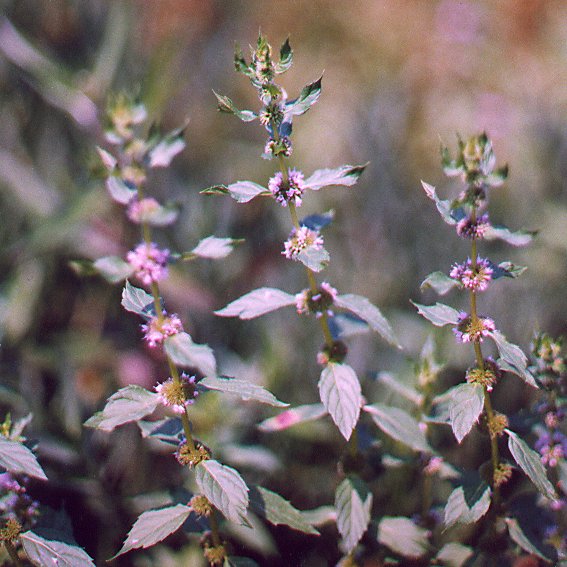Mentha canadensis L.
Corn Mint

Native
CC = 5
CW = -3
MOC = 35
© DETenaglia
Mentha canadensis L.Corn Mint | |
 |
Native CC = 5 CW = -3 MOC = 35 |
© DETenaglia |
|
Family - Lamiaceae Stems - To 80cm tall, herbaceous, 4-angled, typically retrorse strigose above and glabrous below, simple to branching, erect, from fibrous roots, often with adventitious roots from lower nodes, hollow. Leaves - Opposite, petiolate, decussate. Petiole to 2cm long, glabrous. Blade ovate to ovate-lanceolate, to +10cm long, 4cm wide, glabrous above, sparsely pubescent below, punctate, serrate to sub-entire, acute.
Inflorescence - Axillary verticillasters near apex of stems. Each verticillaster composed of two axillary pedunculate cymules of +/-20 flowers each. Peduncles 2mm long. Pedicels 1.5mm long, purplish. Cymules subtended by pair of attenuate bracts. Bracts pubescent, to 5mm long. Flowers - Corolla lavender-purple to whitish, bilabiate(but appearing nearly regular), to +5mm long, glabrous. Corolla tube to 3.5mm long, pubescent. Upper lip single-lobed. Lobe notched at apex, 1.4mm long, pubescent externally. Lower lip 3-lobed. Lobes subequal(central lobe slightly larger), to 1.1mm long, pubescent externally, purple spotted internally. Stamens 4, exserted. Filaments to 1.7mm long, glabrous, pinkish-white. Anthers purple, .3mm long. Style exserted, lilac, 3mm long, glabrous. Stigma 2-lobed. Ovary deeply 4-parted, glabrous, green. Calyx tube to 1.5mm long, pubescent, cylindric, 5-lobed. Lobes .5mm long, acute, with ciliate margins, equal. Nutlets to 1.3mm long, glabrous, tannish.
Flowering - June - October. Habitat - Moist to wet ground. Origin - Native to U.S. Other info. - The pubescence of the leaves and stems is variable and some authors, Steyermark included, like to separate the species into different varieties and forms. These varieties integrate and are sometimes difficult to tell apart so they will not be mentioned here. Photographs taken at the Kansas City Zoo, 7-13-99 and 7-5-00. |